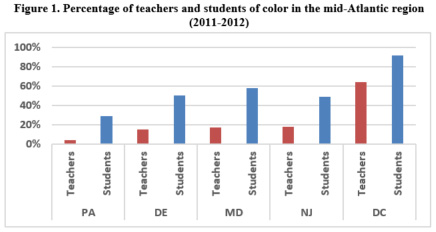
A growing body of research is beginning to confirm what many stakeholders in the mid-Atlantic region already recognize: teacher diversity matters. Research shows that increasing the racial diversity of teachers benefits students. Students of color in particular may benefit from having a same-race teacher. Researchers found that black students from low-income households in North Carolina who had one black teacher in 3rd, 4th, or 5th grade were less likely to drop out of high school and more likely to consider pursuing college. Another study found positive impacts on student achievement in Florida for students who had a same-race teacher.
Mirroring national data on teacher and student demographics, the most recent data for the mid-Atlantic region show that white teachers represent more than 80 percent of the teacher workforce, while students of color make up at least half of the student population in most mid-Atlantic states (Figure 1). With an educator workforce that is anything but diverse, stakeholders in the region urgently seek ways to reduce demographic disparities between students and their teachers.

Leaky pipelines. Education policy must address leaks in the pipeline, which loses prospective educators, particularly people of color, at key junctures. For example, students of color make up one-third of Pennsylvania’s public school enrollment, but only 14 percent of enrollees in teacher preparation programs. Only 10 percent of those who complete teacher preparation identify as people of color. This flow shrinks to a tiny trickle for men of color: of the 8,552 completers of Pennsylvania teacher preparation programs in 2014, 29 were African American men and 20 were Latino men. As a result, only 1 of every 25 teachers in Pennsylvania identifies as a person of color.
Getting and keeping teachers of color. Against the background of growing teacher shortages and the lack of a coordinated national agenda, a patchwork of local initiatives has emerged. Philadelphia launched a teacher residency program in 2017 that aims to attract career-changing teachers of color. Because paraeducators (such as teachers’ assistants) in Delaware disproportionately identify as people of color, Wilmington University began recruiting from these ranks to find those interested in obtaining teaching certification. Meanwhile, the Fellowship: Black Male Educators for Social Justice seeks to recruit and retain black male educators in greater Philadelphia. Nationally, some argue for comprehensive approaches like creating a national teacher corps, intensively recruiting people of color, and improving compensation to attract and retain educators of color. Organizations such as the National Center for Teacher Residencies, Teach For America, and TNTP already use some of these approaches.
Plugging leaks in the pipeline for teachers of color requires a long-term approach to improve postsecondary outcomes for people of color and enhance the appeal of teaching. REL Mid-Atlantic’s research alliance on training and supporting excellent educators is working with states and districts to connect them with research and resources to tackle their pipeline challenges. For example, we’ve partnered with the School District of Philadelphia to better understand teacher retention and mobility, summarized research on teacher residency programs, and are presenting a webinar on October 29 to review innovative approaches for addressing teacher shortages and increasing educator diversity. We look forward to continuing to work with stakeholders in the region to promote a diverse teaching workforce and ultimately improve outcomes for students.
Cross-posted from the REL Mid-Atlantic website.


